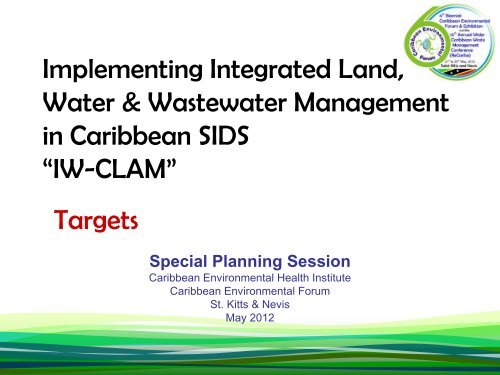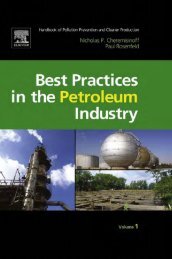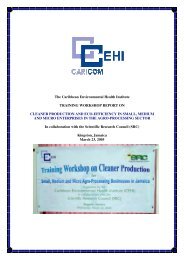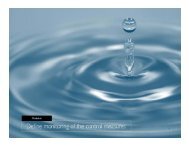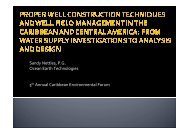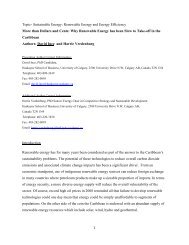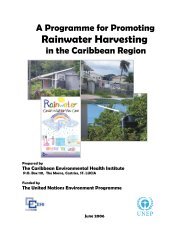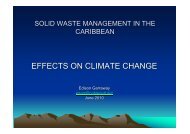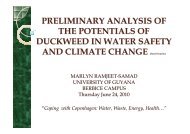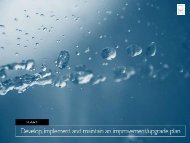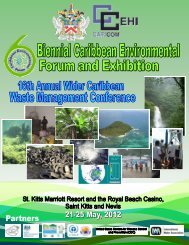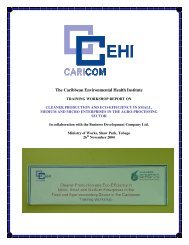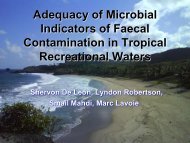IWCAM 2 targets.pdf - Caribbean Environmental Health Institute
IWCAM 2 targets.pdf - Caribbean Environmental Health Institute
IWCAM 2 targets.pdf - Caribbean Environmental Health Institute
You also want an ePaper? Increase the reach of your titles
YUMPU automatically turns print PDFs into web optimized ePapers that Google loves.
Implementing Integrated Land,Water & Wastewater Managementin <strong>Caribbean</strong> SIDS“IW-CLAM”TargetsSpecial Planning Session<strong>Caribbean</strong> <strong>Environmental</strong> <strong>Health</strong> <strong>Institute</strong><strong>Caribbean</strong> <strong>Environmental</strong> ForumSt. Kitts & NevisMay 2012
Project Component 1Targets• Wastewater management thematic area:• Innovative domestic and commercial/industrialeffluent management systems; improved sanitation• Pollution control within agricultural productionsystems• At least 2 investments in small-scale lower cost appropriatetechnology wastewater interventions• At least 2 investments in integrated effluent management(incorporating biogas and resource recycling) developed forintensive livestock (swine, poultry) production systems.
Project Component 1Targets• Water security and improved sanitationthematic area:• RWH systems installed for critically water-stressedcommunities;• reducing risks / expanding water availability withinwater supply systems• At least 2 RWH systems installed for critically waterstressedcommunities to augment existing water supplysystems to improve access to water by 20% over presentavailability;• At least 2 investments in water reuse and recycling at ahigh-consumptive user; (commercial/industrial entity) forreplication toward development/strengthening of Code ofPractices for water conservation
Project Component 1Targets• Land and watershed restoration and ecosystem resiliencethematic area: Upland, riparian, coastal ecosystem restoration andrehabilitation through reforestation and agro-forestry systems• At least 2 investments in upland watershed protection andrestoration measures, incorporating soil fertility amelioration, runoffcontrol in agricultural production systems.• At least 1 investment in riparian restoration, particularly along criticalreaches of river systems upstream of surface water sources andrecharge zones for aquifers and within ecologically degraded areas• At least 1 investment in estuarine and coastal forest/mangroverestoration particularly along vulnerable and high risk areas for storminundation• Watershed management plan development - watershed unit-basedelements of the National Plan of Action to address LBS of pollution• At least 4 watershed basin master plans developed
Project Component 1Targets• Land and watershed restoration andecosystem resilience thematic area:• SFM resources will augment coreinterventions within STAR countries i.e.carbon sequestration over 2,200 ha for atotal of 150,300 tCO2 eq/annum – avoidedcarbon emissions over 2,300ha for total of64,500 tCO2 eq/annum
Project Component 1Targets• Local capacities strengthened• At least 60% of professionals in lead agencies andprimary CSO stakeholders trained in core technicalareas• Measurable stress reduction achieved at theproject sites• Suite of project-specific IW, LD and BD-relatedindicators of process, stress reduction, andenvironmental and socioeconomic status defined• A monitoring protocol for periodic assessmentdefined
Project Component 1Targets• Social and economic welfare of selected islandcommunities improved• Reduced adverse health reports from use of unsafe drinkingand ambient waters (freshwater and coastal waters);• Reduction in risk posed by land degradation to communities(and farmlands• Increase in revenue generation within target communitiesthrough consumptive use of near-shore marine fisheries;• Enhancement in economic activity within target communitiesfrom eco-touristic activity through ecological restoration;• Change in population species abundance and diversitytoward prior natural condition of ecosystem.
Project Component 1Targets• Best practices captured and lessons learneddocumented• Best practice guidelines / code of practices foradoption in national regulations for (inter-alia):• Guidelines for small-footprint wastewater treatment systems andartificial wetland wastewater filtration systems;• Livestock effluent control protocols;• RWH systems installation and management;• Water Safety Plans for small community water supply systems;• Appropriate sanitation solutions for small coastal communities;• Watershed management planning for LBS reduction;• Bioengineering application guidelines for slope stabilization,runoff control and managed aquifer recharge;• Coastal bio-engineering and reforestation methods
Project Component 1Targets• Replication of innovative solutions• Technical exchange visits betweenprofessionals, civil society organizations toshare knowledge directly over the duration ofthe project;• At least 2 major technical conferences andsymposia convened to showcase theinnovative solutions;• Research articles, books, other awarenessmaterials through various media
Project Component 1Targets• Through the GEF-SGP, communitiesundertaking small-scale local levelinterventions• At least 5 small-scale initiativesimplemented across the participatingcountries addressing local challengesassociated with water resources, sustainableland management including coastal zonemanagement and ecosystem impairment
Project Component 2Targets• Regional/ national SLM, IWRM/WUE,ICZM and relevant BD indicators andlong-term monitoring plan• Adoption into national accounts of IW andLD, and BD-related indicators of process,stress reduction, and environmental andsocioeconomic status to monitorimprovements in the management of land andwater resources and wastewater .
Project Component 2Targets• Strengthened national & regional capacity forIWRM and land resources (includingecosystems services) monitoring• Integrative, appropriate decision support tools(water information systems, spatial [GIS]databases) to support the policy development andlegislative reform processes as well as to provide ameasure of success in addressing water quality andwater use problems
Project Component 3Targets• Enhanced coordination among relevant sectors forimplementation• Strengthened National Inter-sectoral Committees (orcomplementary existing bodies based on the NICs establishedduring the GEF-<strong>IWCAM</strong> Project)• National reviews of water, wastewater, and land use policy,legislation and institutional arrangements followed byrecommendations of necessary reforms and support with draftinglegislation• Strengthened policy and legislation• New and/or revised policies and regulations on water supplyand sanitation based on the IWRM Roadmaps (and IWRM/WUEstrategies where they may exist), National Plans of Action forSLM and ecosystem conservation in all participating countries
Project Component 3Targets• Harmonization of National IWRM/WUE processinclusive of SLM and ICZM, and ecosystem servicesmaintenance within relevant national developmentplans• National Integrated Water Resource Management/ WaterUse Efficiency strategies/plans inclusive of ICZM and BDconservation for at least 2 participating countries by Year 4• Strengthened national and regional institutions andother regional, national and local stakeholders• Programmes for of cross-sectoral sensitization andawareness-raising• Programmes for training and capacity building
Project Component 4Targets• Strengthened network for collaboration and exchange of best practices and lessonslearned between other SIDS projects (Pacific and African regions)• Suite of best practices and lessons from other SIDS in SLM/ecosystemsmanagement, IWRM/WUE/ICZM (i.e. Pacific and African), and other projects,particularly in relation to the selection of more suitable and applicabletechnologies• Empowered stakeholder engagement in land and water resources governance -Community of Practices (COP) and other appropriate mechanisms and tools.• Inter-regional SLM and IWRM/WUE/ICZM/BD dialogue process in partnership with the Alliance of SmallIsland States (AOSIS)• A Community of Practice (COP) per SIDS region• Enhanced networking for information sharing, enhanced inter- and intra-regionalknowledge sharing and learning;• Innovative ICT application and web portal• Participation in IW Learn activities - Biennial conferences, preparation of at least 3 experience notes anda website compatible with IW:LEARN Standards;• Hosting of the IWC7;• SIDS learning exchange at regional and global; meetings (Global Oceans Forum, GPA, CWWA, CEFetc• Achieved gender mainstreaming in development/ implementation of SLM/ecosystemsmanagement and IWRM/WUE and ICZM• Gender audits and analysis and training
Project Component 4Targets• Enhanced networking for information sharing,enhanced inter- and intra-regional knowledgesharing and learning;• Innovative ICT application and web portal• Participation in IW Learn activities - Biennial conferences,preparation of at least 3 experience notes and a websitecompatible with IW:LEARN Standards;• Hosting of the IWC7;• SIDS learning exchange at regional and global; meetings(Global Oceans Forum, GPA, CWWA, CEF etc• Achieved gender mainstreaming in development/implementation of SLM/ecosystems managementand IWRM/WUE and ICZM• Gender audits and analysis and training
Questions


